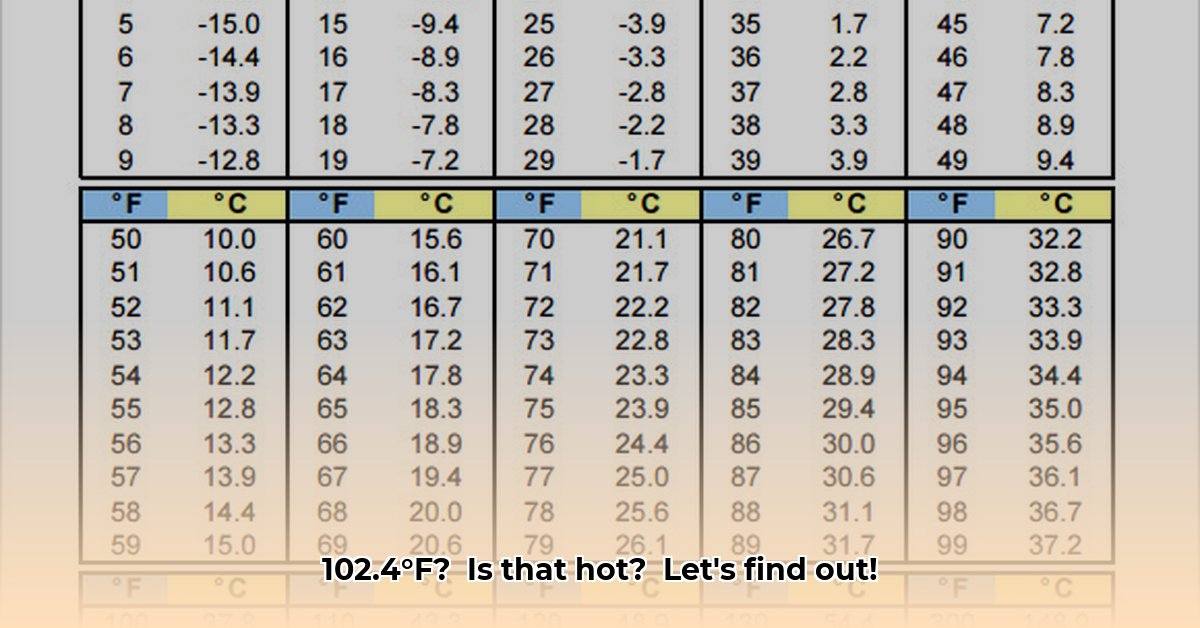(Prominently Displayed Result): 102.4°F equals 39.11°C
(Brief Explanation): This conversion uses the formula: C = (F – 32) * 5/9. Thus, (102.4 – 32) * 5/9 = 39.11°C.
Understanding the Conversion
Fahrenheit (°F) and Celsius (°C) are scales for measuring temperature. Water freezes at 32°F (0°C) and boils at 212°F (100°C). Celsius is more commonly used worldwide. A temperature of 39.11°C is above average human body temperature (37°C) and may indicate a fever.
Is 39.11°C a Fever? What to Do
A temperature of 39.11°C (102.4°F) likely suggests a fever, especially in adults. Fevers are the body’s natural response to infection, but a high fever like this may indicate a more serious condition.
What to look for:
- Chills: Feeling cold despite a high temperature is common with fever.
- Sweating: The body tries to regulate its temperature.
- Muscle aches: Generalized discomfort.
- Fatigue: Feeling unusually tired.
What to do:
- Hydrate: Drink plenty of fluids.
- Over-the-counter medication: Acetaminophen or ibuprofen can help reduce fever and discomfort temporarily.
- Seek medical advice: If the fever persists for more than a few days, worsens, or is accompanied by other symptoms (severe headache, stiff neck, difficulty breathing, confusion), consult a doctor immediately. This is particularly important for children, older adults, and those with underlying health conditions.
Fahrenheit and Celsius: A Deeper Dive
These scales offer different ways to quantify temperature. Fahrenheit, developed by Daniel Gabriel Fahrenheit, originally used a brine solution’s freezing point as zero. Celsius, part of the metric system, uses the freezing point of water (0°C) and its boiling point (100°C) as reference points.
Temperature Conversion Formula and Examples
The formula to convert Fahrenheit to Celsius is: C = (F – 32) * 5/9
Example: 102.4°F
- Subtract 32: 102.4 – 32 = 70.4
- Multiply by 5: 70.4 * 5 = 352
- Divide by 9: 352 / 9 = 39.11°C
Quick Reference Table:
| Fahrenheit (°F) | Celsius (°C) | Description |
|---|---|---|
| 32 | 0 | Freezing point of water |
| 98.6 | 37 | Average human body temperature |
| 100.4 | 38 | Slightly elevated body temperature |
| 102.4 | 39.11 | Indicates a fever |
| 104 | 40 | High fever |
| 212 | 100 | Boiling point of water |
Ongoing Research
While our current knowledge of fever is extensive, research continues to explore the complexities of the body’s temperature regulation and immune response. Scientists are investigating more targeted fever-reducing strategies and the intricate relationship between fever and the immune system. Some researchers suggest that even minor temperature fluctuations can have significant physiological effects. This underscores the importance of seeking professional medical advice when fever is a concern.
Disclaimer: This information is for educational purposes only and should not be considered medical advice. Always consult with a healthcare professional if you have concerns about your health.
- Bento Box Trays Streamline Restaurant Meal Presentation and Transport - December 13, 2025
- Plastic Bento Boxes Face Scrutiny Over Sustainability Impacts - December 11, 2025
- Bento Tray Revolutionizes Organized Meal Transport and Presentation - December 10, 2025










